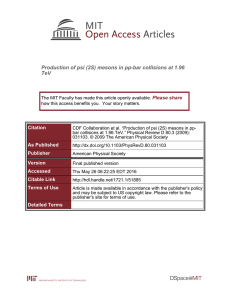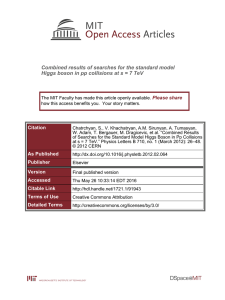Search for a Standard Model Higgs Boson in WH-->lvbb- Please share
advertisement
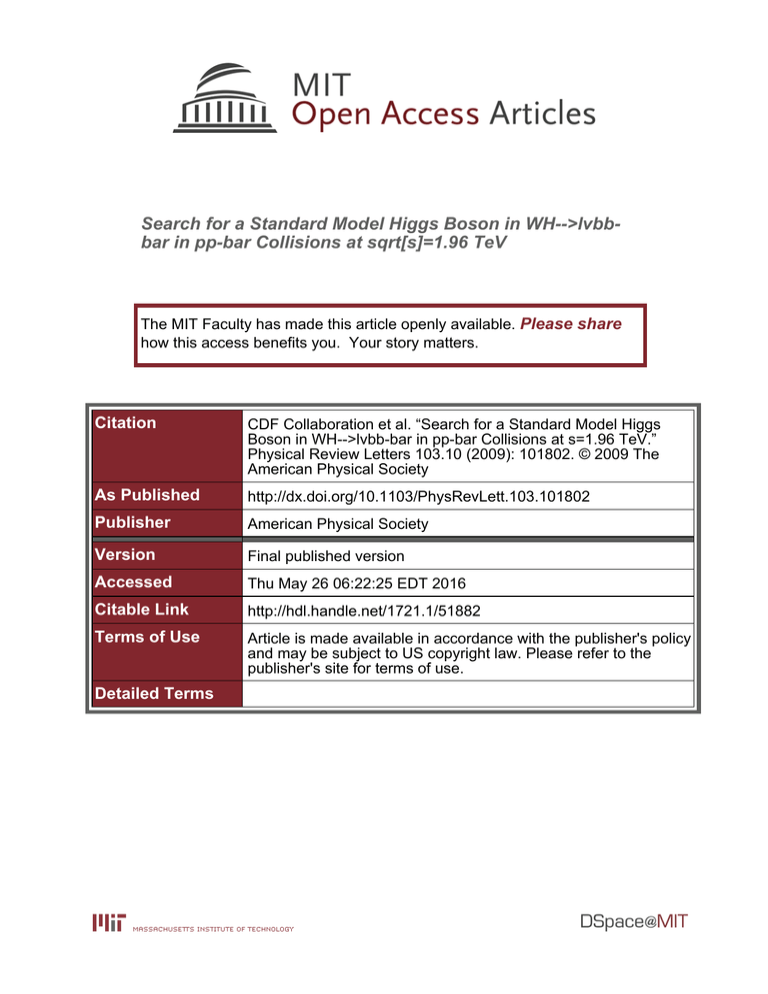
Search for a Standard Model Higgs Boson in WH-->lvbbbar in pp-bar Collisions at sqrt[s]=1.96 TeV The MIT Faculty has made this article openly available. Please share how this access benefits you. Your story matters. Citation CDF Collaboration et al. “Search for a Standard Model Higgs Boson in WH-->lvbb-bar in pp-bar Collisions at s=1.96 TeV.” Physical Review Letters 103.10 (2009): 101802. © 2009 The American Physical Society As Published http://dx.doi.org/10.1103/PhysRevLett.103.101802 Publisher American Physical Society Version Final published version Accessed Thu May 26 06:22:25 EDT 2016 Citable Link http://hdl.handle.net/1721.1/51882 Terms of Use Article is made available in accordance with the publisher's policy and may be subject to US copyright law. Please refer to the publisher's site for terms of use. Detailed Terms PRL 103, 101802 (2009) PHYSICAL REVIEW LETTERS week ending 4 SEPTEMBER 2009 pffiffiffi Search for a Standard Model Higgs Boson in WH ! ‘vbb in pp Collisions at s ¼ 1:96 TeV T. Aaltonen,24 J. Adelman,14 T. Akimoto,56 B. Álvarez González,12,s S. Amerio,44b,44a D. Amidei,35 A. Anastassov,39 A. Annovi,20 J. Antos,15 G. Apollinari,18 A. Apresyan,49 T. Arisawa,58 A. Artikov,16 W. Ashmanskas,18 A. Attal,4 A. Aurisano,54 F. Azfar,43 P. Azzurri,47d,47a W. Badgett,18 A. Barbaro-Galtieri,29 V. E. Barnes,49 B. A. Barnett,26 V. Bartsch,31 G. Bauer,33 P.-H. Beauchemin,34 F. Bedeschi,44a D. Beecher,31 S. Behari,26 G. Bellettini,47b,47a J. Bellinger,60 D. Benjamin,17 A. Beretvas,18 J. Beringer,29 A. Bhatti,51 M. Binkley,18 D. Bisello,44b,44a I. Bizjak,31,w R. E. Blair,2 C. Blocker,7 B. Blumenfeld,26 A. Bocci,17 A. Bodek,50 V. Boisvert,50 G. Bolla,49 D. Bortoletto,49 J. Boudreau,48 A. Boveia,11 B. Brau,11,b A. Bridgeman,25 L. Brigliadori,44a C. Bromberg,36 E. Brubaker,14 J. Budagov,16 H. S. Budd,50 S. Budd,25 S. Burke,18 K. Burkett,18 G. Busetto,44b,44a P. Bussey,22,l A. Buzatu,34 K. L. Byrum,2 S. Cabrera,17,v C. Calancha,32 M. Campanelli,36 M. Campbell,35 F. Canelli,14,18 A. Canepa,46 B. Carls,25 D. Carlsmith,60 R. Carosi,47a S. Carrillo,19,n S. Carron,34 B. Casal,12 M. Casarsa,18 A. Castro,6b,6a P. Catastini,47c,47a D. Cauz,55b,55a V. Cavaliere,47c,47a M. Cavalli-Sforza,4 A. Cerri,29 L. Cerrito,31,o S. H. Chang,28 Y. C. Chen,1 M. Chertok,8 G. Chiarelli,47a G. Chlachidze,18 F. Chlebana,18 K. Cho,28 D. Chokheli,16 J. P. Chou,23 G. Choudalakis,33 S. H. Chuang,53 K. Chung,13 W. H. Chung,60 Y. S. Chung,50 T. Chwalek,27 C. I. Ciobanu,45 M. A. Ciocci,47c,47a A. Clark,21 D. Clark,7 G. Compostella,44a M. E. Convery,18 J. Conway,8 M. Cordelli,20 G. Cortiana,44b,44a C. A. Cox,8 D. J. Cox,8 F. Crescioli,47b,47a C. Cuenca Almenar,8,v J. Cuevas,12,s R. Culbertson,18 J. C. Cully,35 D. Dagenhart,18 M. Datta,18 T. Davies,22 P. de Barbaro,50 S. De Cecco,52a A. Deisher,29 G. De Lorenzo,4 M. Dell’Orso,47b,47a C. Deluca,4 L. Demortier,51 J. Deng,17 M. Deninno,6a P. F. Derwent,18 G. P. di Giovanni,45 C. Dionisi,52b,52a B. Di Ruzza,55b,55a J. R. Dittmann,5 M. D’Onofrio,4 S. Donati,47b,47a P. Dong,9 J. Donini,44a T. Dorigo,44a S. Dube,53 J. Efron,40 A. Elagin,54 R. Erbacher,8 D. Errede,25 S. Errede,25 R. Eusebi,18 H. C. Fang,29 S. Farrington,43 W. T. Fedorko,14 R. G. Feild,61 M. Feindt,27 J. P. Fernandez,32 C. Ferrazza,47d,47a R. Field,19 G. Flanagan,49 R. Forrest,8 M. J. Frank,5 M. Franklin,23 J. C. Freeman,18 I. Furic,19 M. Gallinaro,52a J. Galyardt,13 F. Garberson,11 J. E. Garcia,21 A. F. Garfinkel,49 K. Genser,18 H. Gerberich,25 D. Gerdes,35 A. Gessler,27 S. Giagu,52b,52a V. Giakoumopoulou,3 P. Giannetti,47a K. Gibson,48 J. L. Gimmell,50 C. M. Ginsburg,18 N. Giokaris,3 M. Giordani,55b,55a P. Giromini,20 M. Giunta,47b,47a G. Giurgiu,26 V. Glagolev,16 D. Glenzinski,18 M. Gold,38 N. Goldschmidt,19 A. Golossanov,18 G. Gomez,12 G. Gomez-Ceballos,33 M. Goncharov,33 O. González,32 I. Gorelov,38 A. T. Goshaw,17 K. Goulianos,51 A. Gresele,44b,44a S. Grinstein,23 C. Grosso-Pilcher,14 R. C. Group,18 U. Grundler,25 J. Guimaraes da Costa,23 Z. Gunay-Unalan,36 C. Haber,29 K. Hahn,33 S. R. Hahn,18 E. Halkiadakis,53 B.-Y. Han,50 J. Y. Han,50 F. Happacher,20 K. Hara,56 D. Hare,53 M. Hare,57 S. Harper,43 R. F. Harr,59 R. M. Harris,18 M. Hartz,48 K. Hatakeyama,51 C. Hays,43 M. Heck,27 A. Heijboer,46 J. Heinrich,46 C. Henderson,33 M. Herndon,60 J. Heuser,27 S. Hewamanage,5 D. Hidas,17 C. S. Hill,11,d D. Hirschbuehl,27 A. Hocker,18 S. Hou,1 M. Houlden,30 S.-C. Hsu,29 B. T. Huffman,43 R. E. Hughes,40 U. Husemann,36 M. Hussein,36 U. Husemann,61 J. Huston,36 J. Incandela,11 G. Introzzi,47a M. Iori,52b,52a A. Ivanov,8 E. James,18 B. Jayatilaka,17 E. J. Jeon,28 M. K. Jha,6a S. Jindariani,18 W. Johnson,8 M. Jones,49 K. K. Joo,28 S. Y. Jun,13 J. E. Jung,28 T. R. Junk,18 T. Kamon,54 D. Kar,19 P. E. Karchin,59 Y. Kato,42 R. Kephart,18 J. Keung,46 V. Khotilovich,54 B. Kilminster,18 D. H. Kim,28 H. S. Kim,28 H. W. Kim,28 J. E. Kim,28 M. J. Kim,20 S. B. Kim,28 S. H. Kim,56 Y. K. Kim,14 N. Kimura,56 L. Kirsch,7 S. Klimenko,19 B. Knuteson,33 B. R. Ko,17 K. Kondo,58 D. J. Kong,28 J. Konigsberg,19 A. Korytov,19 A. V. Kotwal,17 M. Kreps,27 J. Kroll,46 D. Krop,14 N. Krumnack,5 M. Kruse,17 V. Krutelyov,11 T. Kubo,56 T. Kuhr,27 N. P. Kulkarni,59 M. Kurata,56 S. Kwang,14 A. T. Laasanen,49 S. Lami,47a S. Lammel,18 M. Lancaster,31 R. L. Lander,8 K. Lannon,40,r A. Lath,53 G. Latino,47c,47a I. Lazzizzera,44b,44a T. LeCompte,2 E. Lee,54 H. S. Lee,14 S. W. Lee,54,u S. Leone,47a J. D. Lewis,18 C.-S. Lin,29 J. Linacre,43 M. Lindgren,18 E. Lipeles,46 A. Lister,8 D. O. Litvintsev,18 C. Liu,48 T. Liu,18 N. S. Lockyer,46 A. Loginov,61 M. Loreti,44b,44a L. Lovas,15 D. Lucchesi,44b,44a C. Luci,52b,52a J. Lueck,27 P. Lujan,29 P. Lukens,18 G. Lungu,51 L. Lyons,43 J. Lys,29 R. Lysak,15 D. MacQueen,34 R. Madrak,18 K. Maeshima,18 K. Makhoul,33 T. Maki,24 P. Maksimovic,26 S. Malde,43 S. Malik,31 G. Manca,30,f A. Manousakis-Katsikakis,3 F. Margaroli,49 C. Marino,27 C. P. Marino,25 A. Martin,61 V. Martin,22,m M. Martı́nez,4 R. Martı́nez-Balları́n,32 T. Maruyama,56 P. Mastrandrea,52a T. Masubuchi,56 M. Mathis,26 M. E. Mattson,59 P. Mazzanti,6a K. S. McFarland,50 P. McIntyre,54 R. McNulty,30,k A. Mehta,30 P. Mehtala,24 A. Menzione,47a P. Merkel,49 C. Mesropian,51 T. Miao,18 N. Miladinovic,7 R. Miller,36 C. Mills,23 M. Milnik,27 A. Mitra,1 G. Mitselmakher,19 H. Miyake,56 N. Moggi,6a C. S. Moon,28 R. Moore,18 M. J. Morello,47b,47a J. Morlock,27 P. Movilla Fernandez,18 J. Mülmenstädt,29 A. Mukherjee,18 Th. Muller,27 R. Mumford,26 P. Murat,18 M. Mussini,6b,6a J. Nachtman,18 Y. Nagai,56 A. Nagano,56 J. Naganoma,56 K. Nakamura,56 I. Nakano,41 A. Napier,57 V. Necula,17 J. Nett,60 C. Neu,6a,46 0031-9007=09=103(10)=101802(8) 101802-1 Ó 2009 The American Physical Society PRL 103, 101802 (2009) PHYSICAL REVIEW LETTERS week ending 4 SEPTEMBER 2009 M. S. Neubauer,25 S. Neubauer,27 J. Nielsen,29,h L. Nodulman,2 M. Norman,10 O. Norniella,25 E. Nurse,31 L. Oakes,43 S. H. Oh,17 Y. D. Oh,28 I. Oksuzian,19 T. Okusawa,42 R. Orava,62 K. Osterberg,24 S. Pagan Griso,44b,44a E. Palencia,18 V. Papadimitriou,18 A. Papaikonomou,27 A. A. Paramonov,14 B. Parks,40 S. Pashapour,34 J. Patrick,18 G. Pauletta,55b,55a M. Paulini,13 C. Paus,33 T. Peiffer,27 D. E. Pellett,8 A. Penzo,55a T. J. Phillips,17 G. Piacentino,47a E. Pianori,46 L. Pinera,19 K. Pitts,25 C. Plager,9 L. Pondrom,60 O. Poukhov,16,a N. Pounder,43 F. Prakoshyn,16 A. Pronko,18 J. Proudfoot,2 F. Ptohos,18,j E. Pueschel,13 G. Punzi,47b,47a J. Pursley,60 J. Rademacker,43,d A. Rahaman,48 V. Ramakrishnan,60 N. Ranjan,49 I. Redondo,32 P. Renton,43 M. Renz,27 M. Rescigno,52a S. Richter,27 F. Rimondi,6b,6a L. Ristori,47a A. Robson,22 T. Rodrigo,12 T. Rodriguez,46 E. Rogers,25 S. Rolli,57 R. Roser,18 M. Rossi,55a R. Rossin,11 P. Roy,34 A. Ruiz,12 J. Russ,13 V. Rusu,18 H. Saarikko,24 A. Safonov,54 W. K. Sakumoto,50 O. Saltó,4 L. Santi,55b,55a S. Sarkar,52b,52a L. Sartori,47a K. Sato,18 A. Savoy-Navarro,45 P. Schlabach,18 A. Schmidt,27 E. E. Schmidt,18 M. A. Schmidt,14 M. P. Schmidt,61,a M. Schmitt,39 T. Schwarz,8 L. Scodellaro,12 A. Scribano,47c,47a F. Scuri,47a A. Sedov,49 S. Seidel,38 Y. Seiya,42 A. Semenov,16 L. Sexton-Kennedy,18 F. Sforza,47a A. Sfyrla,25 S. Z. Shalhout,59 T. Shears,30 P. F. Shepard,48 M. Shimojima,56,q S. Shiraishi,14 M. Shochet,14 Y. Shon,60 I. Shreyber,37 A. Sidoti,47a P. Sinervo,34 A. Sisakyan,16 A. J. Slaughter,18 J. Slaunwhite,40 K. Sliwa,57 J. R. Smith,8 F. D. Snider,18 R. Snihur,34 A. Soha,8 S. Somalwar,53 V. Sorin,36 J. Spalding,18 T. Spreitzer,34 P. Squillacioti,47c,47a M. Stanitzki,61 R. St. Denis,22 B. Stelzer,34 O. Stelzer-Chilton,34 D. Stentz,39 J. Strologas,38 G. L. Strycker,35 D. Stuart,11 J. S. Suh,28 A. Sukhanov,19 I. Suslov,16 T. Suzuki,56 A. Taffard,25,g R. Takashima,41 Y. Takeuchi,56 R. Tanaka,41 M. Tecchio,35 P. K. Teng,1 K. Terashi,51 J. Thom,18,i A. S. Thompson,22 G. A. Thompson,25 E. Thomson,46 P. Tipton,61 P. Ttito-Guzmán,32 S. Tkaczyk,18 D. Toback,54 S. Tokar,15 K. Tollefson,36 T. Tomura,56 D. Tonelli,18 S. Torre,20 D. Torretta,18 P. Totaro,55b,55a S. Tourneur,45 M. Trovato,47a S.-Y. Tsai,1 Y. Tu,46 N. Turini,47c,47a F. Ukegawa,56 S. Vallecorsa,21 N. van Remortel,24,c A. Varganov,35 E. Vataga,47d,47a F. Vázquez,19,n G. Velev,18 C. Vellidis,3 M. Vidal,32 R. Vidal,18 I. Vila,12 R. Vilar,12 T. Vine,31 M. Vogel,38 I. Volobouev,29,u G. Volpi,47b,47a P. Wagner,46 R. G. Wagner,2 R. L. Wagner,18 W. Wagner,27 J. Wagner-Kuhr,27 T. Wakisaka,42 R. Wallny,9 S. M. Wang,1 A. Warburton,34 D. Waters,31 M. Weinberger,54 J. Weinelt,27 W. C. Wester III,18 B. Whitehouse,57 D. Whiteson,46,g A. B. Wicklund,2 E. Wicklund,18 S. Wilbur,14 G. Williams,34 H. H. Williams,46 P. Wilson,18 B. L. Winer,40 P. Wittich,18,i S. Wolbers,18 C. Wolfe,14 T. Wright,35 X. Wu,21 F. Würthwein,10 S. Xie,33 A. Yagil,10 K. Yamamoto,42 J. Yamaoka,17 U. K. Yang,14,p Y. C. Yang,28 W. M. Yao,29 G. P. Yeh,18 J. Yoh,18 K. Yorita,58 T. Yoshida,42 G. B. Yu,50 I. Yu,28 S. S. Yu,18 J. C. Yun,18 L. Zanello,52b,52a A. Zanetti,55a X. Zhang,25 Y. Zheng,9,e and S. Zucchelli6b,6a (CDF Collaboration) 1 Institute of Physics, Academia Sinica, Taipei, Taiwan 11529, Republic of China 2 Argonne National Laboratory, Argonne, Illinois 60439, USA 3 University of Athens, 157 71 Athens, Greece 4 Institut de Fisica d’Altes Energies, Universitat Autonoma de Barcelona, E-08193, Bellaterra (Barcelona), Spain 5 Baylor University, Waco, Texas 76798, USA 6a Istituto Nazionale di Fisica Nucleare Bologna, I-40127 Bologna, Italy 6b University of Bologna, I-40127 Bologna, Italy 7 Brandeis University, Waltham, Massachusetts 02254, USA 8 University of California, Davis, Davis, California 95616, USA 9 University of California, Los Angeles, Los Angeles, California 90024, USA 10 University of California, San Diego, La Jolla, California 92093, USA 11 University of California, Santa Barbara, Santa Barbara, California 93106, USA 12 Instituto de Fisica de Cantabria, CSIC-University of Cantabria, 39005 Santander, Spain 13 Carnegie Mellon University, Pittsburgh, Pennsylvania 15213, USA 14 Enrico Fermi Institute, University of Chicago, Chicago, Illinois 60637, USA 15 Comenius University, 842 48 Bratislava, Slovakia; Institute of Experimental Physics, 040 01 Kosice, Slovakia 16 Joint Institute for Nuclear Research, RU-141980 Dubna, Russia 17 Duke University, Durham, North Carolina 27708, USA 18 Fermi National Accelerator Laboratory, Batavia, Illinois 60510, USA 19 University of Florida, Gainesville, Florida 32611, USA 20 Laboratori Nazionali di Frascati, Istituto Nazionale di Fisica Nucleare, I-00044 Frascati, Italy 21 University of Geneva, CH-1211 Geneva 4, Switzerland 22 Glasgow University, Glasgow G12 8QQ, United Kingdom 23 Harvard University, Cambridge, Massachusetts 02138, USA 101802-2 PRL 103, 101802 (2009) PHYSICAL REVIEW LETTERS week ending 4 SEPTEMBER 2009 24 Division of High Energy Physics, Department of Physics, University of Helsinki and Helsinki Institute of Physics, FIN-00014, Helsinki, Finland 25 University of Illinois, Urbana, Illinois 61801, USA 26 The Johns Hopkins University, Baltimore, Maryland 21218, USA 27 Institut für Experimentelle Kernphysik, Universität Karlsruhe, 76128 Karlsruhe, Germany 28 Center for High Energy Physics: Kyungpook National University, Daegu 702-701, Korea; Seoul National University, Seoul 151-742, Korea; Sungkyunkwan University, Suwon 440-746, Korea; Korea Institute of Science and Technology Information, Daejeon, 305-806, Korea; Chonnam National University, Gwangju, 500-757, Korea 29 Ernest Orlando Lawrence Berkeley National Laboratory, Berkeley, California 94720, USA 30 University of Liverpool, Liverpool L69 7ZE, United Kingdom 31 University College London, London WC1E 6BT, United Kingdom 32 Centro de Investigaciones Energeticas Medioambientales y Tecnologicas, E-28040 Madrid, Spain 33 Massachusetts Institute of Technology, Cambridge, Massachusetts 02139, USA 34 Institute of Particle Physics: McGill University, Montréal, Québec, Canada H3A 2T8; Simon Fraser University, Burnaby, British Columbia, Canada V5A 1S6; University of Toronto, Toronto, Ontario, Canada M5S 1A7; and TRIUMF, Vancouver, British Columbia, Canada V6T 2A3 35 University of Michigan, Ann Arbor, Michigan 48109, USA 36 Michigan State University, East Lansing, Michigan 48824, USA 37 Institution for Theoretical and Experimental Physics, ITEP, Moscow 117259, Russia 38 University of New Mexico, Albuquerque, New Mexico 87131, USA 39 Northwestern University, Evanston, Illinois 60208, USA 40 The Ohio State University, Columbus, Ohio 43210, USA 41 Okayama University, Okayama 700-8530, Japan 42 Osaka City University, Osaka 588, Japan 43 University of Oxford, Oxford OX1 3RH, United Kingdom 44a Istituto Nazionale di Fisica Nucleare, Sezione di Padova-Trento, I-35131 Padova, Italy 44b University of Padova, I-35131 Padova, Italy 45 LPNHE, Universite Pierre et Marie Curie/IN2P3-CNRS, UMR7585, Paris, F-75252 France 46 University of Pennsylvania, Philadelphia, Pennsylvania 19104, USA 47a Istituto Nazionale di Fisica Nucleare Pisa, I-56127 Pisa, Italy 47b University of Pisa, I-56127 Pisa, Italy 47c University of Siena, I-56127 Pisa, Italy 47d Scuola Normale Superiore, I-56127 Pisa, Italy 48 University of Pittsburgh, Pittsburgh, Pennsylvania 15260, USA 49 Purdue University, West Lafayette, Indiana 47907, USA 50 University of Rochester, Rochester, New York 14627, USA 51 The Rockefeller University, New York, New York 10021, USA 52a Istituto Nazionale di Fisica Nucleare, Sezione di Roma 1, I-00185 Roma, Italy 52b Sapienza Università di Roma, I-00185 Roma, Italy 53 Rutgers University, Piscataway, New Jersey 08855, USA 54 Texas A&M University, College Station, Texas 77843, USA 55a Istituto Nazionale di Fisica Nucleare Trieste/Udine, Italy 55b University of Trieste/Udine, Italy 56 University of Tsukuba, Tsukuba, Ibaraki 305, Japan 57 Tufts University, Medford, Massachusetts 02155 58 Waseda University, Tokyo 169, Japan 59 Wayne State University, Detroit, Michigan 48201, USA 60 University of Wisconsin, Madison, Wisconsin 53706, USA 61 Yale University, New Haven, Connecticut 06520, USA 62 Division of High Energy Physics, Department of Physics, University of Helsinki and Helsinki Institute of Physics, FIN-00014, Helsinki, Finland (Received 2 July 2009; published 1 September 2009) We present a search for a standard model Higgs boson produced in association with a W boson using pffiffiffi 2:7 fb1 of integrated luminosity of pp collision data taken at s ¼ 1:96 TeV. Limits on the Higgs boson production rate are obtained for masses between 100 and 150 GeV=c2 . Through the use of multivariate techniques, the analysis achieves an observed (expected) 95% confidence level upper limit of 5.6 (4.8) 101802-3 PRL 103, 101802 (2009) PHYSICAL REVIEW LETTERS week ending 4 SEPTEMBER 2009 times the theoretically expected production cross section for a standard model Higgs boson with a mass of 115 GeV=c2 . DOI: 10.1103/PhysRevLett.103.101802 PACS numbers: 14.80.Bn, 13.85.Rm, 14.70.Fm The standard model (SM) of particle physics has proven to be an extremely successful theory through its accurate predictions of many experimental results over the last few decades. In the SM, spontaneous electroweak symmetry breaking gives rise to the masses of the W and Z bosons. Although the Higgs mechanism [1–3] was proposed in the 1960s as the source of this symmetry breaking, the fundamental particle it predicts to exist, the Higgs boson, has yet to be discovered. The mass of the Higgs boson is a free parameter of the SM. However, direct limits from the LEP experiments exclude Higgs boson masses below 114:4 GeV=c2 [4] at 95% confidence level (C.L.). Taking into account additional electroweak precision measurements places a 95% C.L. upper limit on the mass of a SM Higgs boson of 185 GeV=c2 [5]. Recently, combined results from the CDF Collaboration and D0 Collaboration experiments have excluded at the 95% C.L. Higgs boson masses between 160 and 170 GeV=c2 [6]. For Higgs boson masses below 135 GeV=c2 , bb is the main decay mode [7]. In this decay, each b quark fragments into a jet of hadrons and the Higgs boson signal may be reconstructed as a peak in the invariant mass distribution of these two jets. At the Tevatron associated production with a W boson (WH), where the W boson decays into a lepton (‘) and a neutrino (), provides one of the most sensitive search channels in this mass range, since the requirements of a charged lepton candidate and of large missing transverse energy dramatically reduce the backgrounds from multijet processes [8]. Both Tevatron experiments, CDF and D0, have published search results for WH ! ‘bb [9–11]. Here we describe a new search for the Higgs boson in the WH ! ‘bb channel with increased signal acceptance that employs improved analysis technique and 2:7 fb1 of pp collision luminosity collected by the CDF experiment. Although we focus on the SM here, many plausible extensions, such as Ref. [12], predict a low-mass SM-like Higgs boson. The CDF II apparatus [13,14] is a general-purpose detector located at the Tevatron collider at Fermilab. The detector consists of a solenoidal charged-particle spectrometer which includes a silicon microstrip detector array surrounded by a cylindrical drift chamber in a 1.4 T axial magnetic field. Outside the tracking chambers, the energies of electrons and jets are measured with segmented sampling calorimeters. Surrounding the calorimeters are layers of steel instrumented with planar drift chambers and scintillators used for muon identification. Events are collected with energetic lepton triggers that require one of the following signatures [15]: a high-pT electron candidate, a high-pT muon candidate, or missing transverse energy (E 6 T from the neutrino escaping detection) with an energetic forward (jj > 1:2) electromagnetic cluster (designed to accept forward electrons from the W boson decay). An additional trigger is included that does not explicitly require an identified lepton, but instead requires large E 6 T plus two well-separated jets in space [16]. For these events, the charged lepton from the W boson decay is reconstructed only as a high-pT isolated track. The addition of this nontriggered lepton category increases WH ! ‘bb signal acceptance by approximately 25% [17]. Candidate events are selected by requiring a lepton candidate (triggered lepton or isolated track) with p‘T > 20 GeV=c, E 6 T > 20 GeV, and two jets with jj < 2:0 and ET > 20 GeV after correcting for instrumental effects [18]. At least one of the jets must have a displaced vertex (b tag) defined by the SECVTX algorithm [19] signaling that the jet likely originated from a b quark. An additional b-tagging algorithm that relies on high-impact-parameter tracks within jets, JETPROB [15], is used to increase the acceptance for double-tagged events. Vetoes are applied to remove events with more than one lepton and events without leptonic W boson decays [11]. The Higgs boson events are modeled with the PYTHIA [20] MC generator combined with a parametrized response of the CDF II detector [21,22] and tuned to the Tevatron underlying event data [23]. After basic event selection, the total expected signal event yield in the current data set is 5:1 0:5 (3:5 0:4) single (double)-tag events for a Higgs boson with a mass of 115 GeV=c2 (see Table I for other masses). Models for background processes are derived from a mixture of MC simulation and data-driven techniques [11]. Important backgrounds to WH ! ‘bb include events with a W or Z boson produced in association with jets. These processes may include true b jets as in W þ bb, or other jets that have been misidentified as b jets like W þ cc and W þ jj, where j refers to jets not originating from heavy-flavor quarks. Events with a top quark (tt and single top quark production), diboson events, and multijet events without W bosons also contribute to the sample composition. After applying the event selection defined above, the background expectation (1896 301 for single-tag and 316 60 for double-tag events) is significantly larger than the expected number of Higgs boson signal events. We have indicated that the dijet invariant mass is a useful variable for separating the Higgs boson signal from the dominant backgrounds, however its usefulness is limited by jet energy resolution and large background rate. These 101802-4 week ending 4 SEPTEMBER 2009 PHYSICAL REVIEW LETTERS PRL 103, 101802 (2009) and the TABLE I. The number of signal events expected to be accepted by our selection, the SM prediction for BðH ! bbÞ, expected and observed limits at 95% C.L. on the Higgs boson production cross section relative to the SM value as shown in Fig. 2. The expected limits are also included for the NN and MEBDT analyses individually. Mass (GeV=c2 ) Expt. signal (events) (fb) SM BðH ! bbÞ Expt. NN (95% C.L./SM) Expt. MEBDT (95% C.L./SM) Expt. combination (95% C.L./SM) Observed (95% C.L./SM) 100 105 110 115 120 125 130 135 140 145 150 12.8 232 4.3 3.8 3.5 3.3 11.7 201 4.6 4.0 3.8 3.6 10.3 169 5.0 4.5 4.1 4.9 8.6 136 5.8 5.2 4.8 5.6 6.9 104 6.9 6.3 5.9 5.9 5.6 83 8.2 8.0 7.2 8.0 4.3 63 10.0 10.0 8.7 8.9 3.1 45 13.8 13.4 12.2 13.2 2.1 30 19.4 19.2 17.5 26.5 1.4 20 28.9 27.0 25.6 42.1 0.9 12 43.2 48.7 40.5 75.5 challenges require that we extract as much discrimination as possible from the full information available in each event. Multivariate techniques allow us to collect the discriminating power of many variables into a single output variable. We take advantage of the benefits from different techniques [24] by combining the discriminating power of two separate analyses that use the same event selection but follow different multivariate strategies. We validate the predictions of the background model for each input variable in data control regions. We optimize the discriminants separately for each Higgs boson mass hypothesis, and construct the discriminants so that they are not sensitive to statistical fluctuations in the background and signal samples. We first summarize the two analyses, and then discuss their combined result. The first analysis uses an artificial neural network (NN, [25]) trained to discriminate WH ! ‘bb signal from the background using the information contained in the following kinematic variables: the invariant mass of the two jets plus an additional ‘‘loose’’ jet [26] if it lies close to one of Double-Tagged WH (× 10) (c) 10 10 W+c c, W+c 20 Events Events W+bb W+jj 1 10-1 10 10 Top Other Data Events Events 150 100 50 3 Single-Tagged 10-1 10 102 10 10 1 Single-Tagged 3 102 Events Single-Tagged 1 10-2 10-2 200 Double-Tagged (b) Events 30 102 Double-Tagged 102 (a) the primary jets [angular separation R ¼ pffiffiffiffiffiffiffiffiffiffiffiffiffiffiffiffiffiffiffiffiffiffiffiffiffiffiffiffiffiffiffiffiffi 2 2 ðÞ þ ðÞ less than 0.9]; the vector sum of the P 6 ~ T ); the scalar sum transverse energies ( jets E~ T þ p~ T ‘ þ E of 6 T P the lepton and jet transverse momenta minus the E ( jets ET þ pT ‘ E 6 T ); the scalar sum of the loose jet P ) [26]; the minimum invariant transverse energy ( jets Eloose T mass of the lepton, E 6 ~ T , and one of the two jets [ minðM‘;E6 T ;j1 ; M‘;E6 T ;j2 Þ]; and R between the lepton and the momentum of the neutrino [27]. The strongest discriminating variable of the NN is the dijet mass variable shown in Fig. 1(a). The second analysis uses a boosted decision tree technique (MEBDT, [28,29]). The notation MEBDT underscores the use of inputs derived from the matrix-element approach developed in Refs. [30,31]. In the matrix-element method, probability densities are calculated for each event using the measured kinematic quantities. Some of the best discriminating inputs to the decision tree include ratios of the signal event probabilities to various combinations of 1 10-1 10-1 10-2 0 0 100 200 300 2 Mjj [GeV/c ] 400 0 0.2 0.4 0.6 0.8 Event Probability Discriminant 1 0 0.2 0.4 0.6 0.8 1 Super-discriminant Output FIG. 1 (color online). The distribution for the dijet mass variable used in the NN analysis (a), the event probability discriminant used in the MEBDT analysis (b), and the SD output distribution (c), for double b-tag events (top) and single b-tag events (bottom). The background is normalized to its prediction and the signal expectation of a Higgs boson mass of 115 GeV=c2 is scaled to 10 times the SM prediction. Statistical errors are shown for the data points. 101802-5 the background probabilities, and an event probability discriminant (EPD) defined as the ratio of the signal event probability to the sum of the signal and all background event probabilities as in Ref. [30]. The EPD distributions for signal and backgrounds are shown in Fig. 1(b). The MEBDT analysis also uses the output of a neural network that has been trained to separate jet flavors [32]. This network is based on secondary vertex tracking information and provides a continuous variable which helps to identify the portion of the background that does not contain real b-quark jets. The MEBDT analysis also includes the following inputs: the dijet mass, the ET of both jets and E 6 T of the event, the difference in azimuthal angles () between the leading jet and the E 6 ~ T , the between the lepton and the E 6 ~ T , the pT and the ofP the lepton, the scalar 6 T, sum of the transverse energies HT ¼ jets ET þ pT ‘ þ E the cosine of the angle between the lepton and leading jet, and the transverse mass of the W boson MT ðWÞ ¼ qffiffiffiffiffiffiffiffiffiffiffiffiffiffiffiffiffiffiffiffiffiffiffiffiffiffiffiffiffiffiffiffiffiffiffiffiffiffiffiffiffiffiffiffi 6 p~ ‘ E 6 ~ Þ. 2ðp ‘ E T T T week ending 4 SEPTEMBER 2009 PHYSICAL REVIEW LETTERS T We performed the NN and the MEBDT analyses independently (see Table I), the results of which are partially correlated. The correlations between the discriminant outputs range between 50% and 75% for the major background and signal samples. These correlations, while high, do suggest that a sensitivity gain can be obtained by combining the two approaches. We combine the NN and MEBDT discriminants using a superdiscriminant (SD) technique first developed in the CDF single top quark search [30]. Here, a neural network using the discriminant outputs of the NN and MEBDT as inputs is optimized using genetic algorithms [33–35]. Three separate neural networks (one for each b-tag category: single SECVTX, SECVTX þ JETPROB, and double SECVTX) are trained to separate the WH ! ‘bb signal from the backgrounds for each Higgs boson mass using events from the signal and background samples described above. The distributions of the SD outputs of the neural network trained for a Higgs boson mass of 115 GeV=c2 are shown in Fig. 1(c) for the combined double-tag categories and the single-tag category. The SD analysis improves the sensitivity compared to the best individual analysis by 5%–13% for the Higgs boson masses studied. Finding no evidence for a Higgs boson signal, we calculate a Bayesian C.L. limit for each mass hypothesis based on the combined binned likelihood of the SD output distributions. The two lepton categories (triggered leptons and isolated tracks) and three tag categories yield six independent channels that are included in the likelihood. Systematic uncertainties on the rate of signal and background production from jet energy scale, b-tagging efficiencies, lepton identification and trigger efficiencies, the amount of initial and final state radiation, and the parton distribution functions are included in the limit calculation (for details on systematic studies, see [11,17]). Uncertainties on the discriminant output shapes were studied but found to have a negligible impact on sensitivity. A posterior density is obtained by multiplying this likelihood by Gaussian prior densities for the background normalizations and systematic uncertainties leaving with a uniform prior density. A 95% C.L. limit BðH ! bbÞ is then determined such that 95% of the posterior density falls below the limit [36]. Removing for BðH ! bbÞ systematic uncertainties completely from the limit calculation improves the expected limit by about 15%. Table I shows the expected and observed limits calculated for different Higgs boson masses. The limits are displayed graphically in Fig. 2. We find an observed (expected) 95% C.L. limit of 5.6 (4.8) times the SM prediction of the production cross section for a Higgs boson mass of 115 GeV=c2 (next-to-leading order theory predicts ¼ 136 fb [37]). At this mass, the expected BðH ! bbÞ limit has improved by a factor of 1.7 over the 1:9 fb1 result from CDF [11], which corresponds to a 40% improvement in sensitivity over what is expected from the increased data set [38]. The additional gain comes from our increased lepton acceptance through the inclusion of a nontriggered lepton category, a continuous jet flavor separator variable which improves discrimination of lightquark jets mistakenly tagged as b jets, and the use of new multivariate techniques. The excess in the observed limit at higher masses is due primarily to the slight excess observed at 150 GeV=c2 in the dijet mass variable [see Fig. 1(a)] and is an indication of the large weight this variable carries in the full multivariate analysis. The successful previous application of many of the techniques to the CDF single top analysis [30,39], and the consistency of results obtained with NN and MEBDT algorithms provide further confidence in the robustness of the multivariate techniques. The increasing Tevatron data set together with future analysis improvements, a combination of reMedian Expected ± 2 σ 102 Median Expected ± 1 σ Median Expected WH combination 95% C.L. Limit/SM PRL 103, 101802 (2009) Observed WH combination 10 1 100 110 120 130 140 150 2 Higgs Mass (GeV/c ) FIG. 2 (color online). The expected and observed 95% C.L. upper limits on the Higgs boson production cross section relative to the SM expectation as obtained from the SD combination as a function of the Higgs boson mass. 101802-6 PRL 103, 101802 (2009) PHYSICAL REVIEW LETTERS sults from all Higgs boson production and decay modes, as well as the combination with the results from the D0 experiment [6], will continue to provide improved levels of sensitivity to the SM Higgs boson searches at the Tevatron. We thank the Fermilab staff and the technical staffs of the participating institutions for their vital contributions. This work was supported by the U.S. Department of Energy and National Science Foundation; the Italian Istituto Nazionale di Fisica Nucleare; the Ministry of Education, Culture, Sports, Science and Technology of Japan; the Natural Sciences and Engineering Research Council of Canada; the National Science Council of the Republic of China; the Swiss National Science Foundation; the A. P. Sloan Foundation; the Bundesministerium für Bildung und Forschung, Germany; the Korean Science and Engineering Foundation and the Korean Research Foundation; the Science and Technology Facilities Council and the Royal Society, U.K.; the Institut National de Physique Nucleaire et Physique des Particules/CNRS; the Russian Foundation for Basic Research; the Ministerio de Ciencia e Innovación, and Programa Consolider-Ingenio 2010, Spain; the Slovak R&D Agency; and the Academy of Finland. a Deceased. Visitor from University of Massachusetts Amherst, Amherst, MA 01003, USA. c Visitor from Universiteit Antwerpen, B-2610 Antwerp, Belgium. d Visitor from University of Bristol, Bristol BS8 1TL, U.K. e Visitor from Chinese Academy of Sciences, Beijing 100864, China. f Visitor from Istituto Nazionale di Fisica Nucleare, Sezione di Cagliari, 09042 Monserrato (Cagliari), Italy. g Visitor from University of California Irvine, Irvine, CA 92697, USA. h Visitor from University of California Santa Cruz, Santa Cruz, CA 95064, USA. i Visitor from Cornell University, Ithaca, NY 14853, USA. j Visitor from University of Cyprus, Nicosia CY-1678, Cyprus. k Visitor from University College Dublin, Dublin 4, Ireland. l Visitor from Royal Society of Edinburgh, Edinburgh, EH2 2PQ, U.K. m Visitor from University of Edinburgh, Edinburgh EH9 3JZ, U.K. n Visitor from Universidad Iberoamericana, Mexico D.F., Mexico. o Visitor from Queen Mary, University of London, London, E1 4NS, U.K. p Visitor from University of Manchester, Manchester M13 9PL, U.K. b q week ending 4 SEPTEMBER 2009 Visitor from Nagasaki Institute of Applied Science, Nagasaki, Japan. r Visitor from University of Notre Dame, Notre Dame, IN 46556, USA. s Visitor from University de Oviedo, E-33007 Oviedo, Spain. t Visitor from Texas Tech University, Lubbock, TX 79409, USA. u Visitor from IFIC(CSIC-Universitat de Valencia), 46071 Valencia, Spain. v Visitor from University of Virginia, Charlottesville, VA 22904, USA. w On leave from J. Stefan Institute, Ljubljana, Slovenia. [1] P. W. Higgs, Phys. Rev. Lett. 13, 508 (1964). [2] G. S. Guralnik, C. R. Hagen, and T. W. B. Kibble, Phys. Rev. Lett. 13, 585 (1964). [3] F. Englert and R. Brout, Phys. Rev. Lett. 13, 321 (1964). [4] R. Barate et al. (LEP Higgs Working Group), Phys. Lett. B 565, 61 (2003). [5] LEP-Tevatron-SLD Electroweak Working Group, arXiv:0811.4682. [6] Tevatron New Phenomena and Higgs Working Group (CDF and D0 Collaborations), arXiv:0903.4001. [7] A. Djouadi, J. Kalinowski, and M. Spira, Comput. Phys. Commun. 108, 56 (1998). [8] M. S. Carena et al. (Tevatron Higgs Working Group), arXiv:hep-ph/0010338. [9] T. Aaltonen et al. (CDF Collaboration), Phys. Rev. D 78, 032008 (2008). [10] V. M. Abazov et al. (D0 Collaboration), Phys. Rev. Lett. 102, 051803 (2009). [11] T. Aaltonen et al. (CDF Collaboration), arXiv:0905.3155 [Phys. Rev. D (to be published)]. [12] L. Roszkowski, R. R. de Austri, and R. Trotta, J. High Energy Phys. 04 (2007) 084. [13] D. E. Acosta et al. (CDF Collaboration), Phys. Rev. D 71, 032001 (2005). [14] We use a cylindrical coordinate system with the origin at the center of the CDF detector, z pointing in the direction of the proton beam, and representing the polar and azimuthal angles, respectively, and pseudorapidity defined by ¼ ln tanð=2Þ. The transverse momentum pT (transverse energy ET ) is defined to be pPsin (E sin). The missing ET (E 6 ~ T ) is defined by E 6 ~ T ¼ i EiT n^ i , n^ i is a unit vector perpendicular to the beam axis and pointing at the ith calorimeter tower (E 6 T ¼ jE 6 ~ T j). [15] A. Abulencia et al. (CDF Collaboration), Phys. Rev. D 74, 072006 (2006). [16] T. Aaltonen et al. (CDF Collaboration), Phys. Rev. Lett. 100, 211801 (2008). [17] J. Slaunwhite, Ph.D. thesis, The Ohio State University [Report No. FERMILAB-THESIS-2009-01]. [18] A. Bhatti et al., Nucl. Instrum. Methods Phys. Res., Sect. A 566, 375 (2006). [19] D. E. Acosta et al. (CDF Collaboration), Phys. Rev. D 71, 052003 (2005). [20] T. Sjostrand et al., Comput. Phys. Commun. 135, 238 (2001). [21] R. Brun et al., CERN Report No. CERN-DD/EE/84-1, 1987. 101802-7 PRL 103, 101802 (2009) PHYSICAL REVIEW LETTERS [22] G. Grindhammer, M. Rudowicz, and S. Peters, Nucl. Instrum. Methods Phys. Res., Sect. A 290, 469 (1990). [23] R. Field and R. C. Group, arXiv:hep-ph/0510198. [24] T. Aaltonen et al. (CDF Collaboration), Phys. Rev. Lett. 102, 021802 (2009). [25] C. Peterson, T. Rognvaldsson, and L. Lonnblad, Comput. Phys. Commun. 81, 185 (1994). [26] ‘‘Loose’’ jets are defined to be exclusive to our primary jet definition (jj < 2:0 and ET > 20 GeV) with jj < 2:4 and ET > 12 GeV. [27] The neutrino pz is chosen as the solution of the W mass constraint equation that gives the largest jpz j for the neutrino. [28] A. Hocker et al., Proc. Sci. ACAT2007 (2007) 040. [29] L. Breiman et al., Classification and Regression Trees (Wadsworth and Brooks, Monterey, CA, 1984). [30] T. Aaltonen et al. (CDF Collaboration), Phys. Rev. Lett. 101, 252001 (2008). week ending 4 SEPTEMBER 2009 [31] P. J. Dong, Ph.D. thesis, University of California, Los Angeles [Report No. FERMILAB-THESIS-2008-12]. [32] S. Richter, Ph.D. thesis, University of Karlsruhe [Report No. FERMILAB-THESIS-2007-35]. [33] K. Stanley and R. Miikkulainen, Evolutionary Comput. 10, 99 (2002). [34] S. Whiteson and D. Whiteson, arXiv:hep-ex/0607012. [35] T. Aaltonen et al. (CDF Collaboration), Phys. Rev. Lett. 102, 152001 (2009). [36] C. Amsler et al. (Particle Data Group), Phys. Lett. B 667, 1 (2008). [37] T. Han and S. Willenbrock, Phys. Lett. B 273, 167 (1991). [38] We assume that the sensitivity would scale inversely to the square root of the integrated luminosity in the absence of analysis improvements. [39] T. Aaltonen et al. (CDF Collaboration), arXiv:0903.0885 [Phys. Rev. Lett. (to be published)]. 101802-8
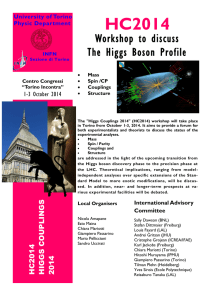
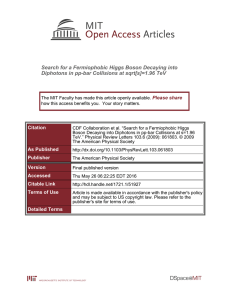
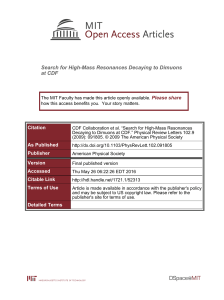
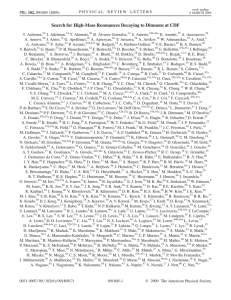
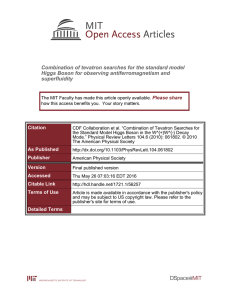
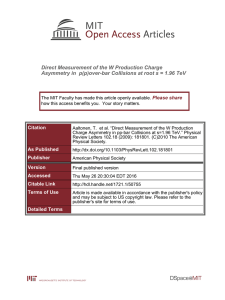
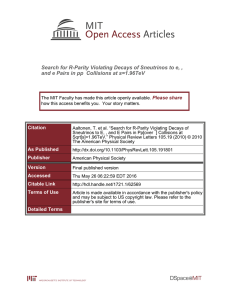
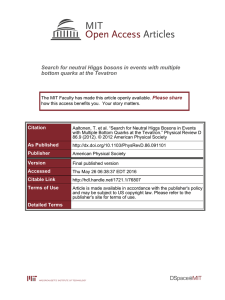
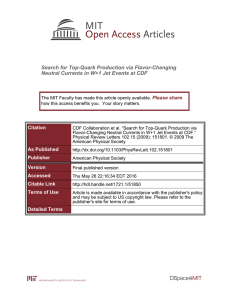
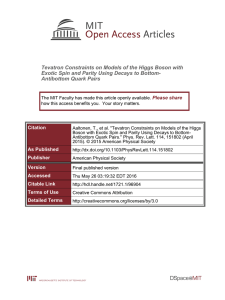
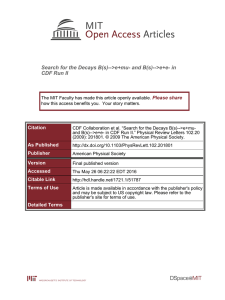
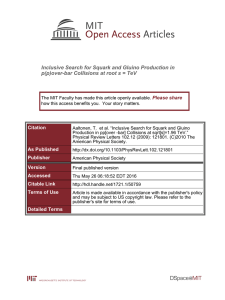
![Observation of Exclusive Charmonium Production and sqrt[s]=1.96 TeV](http://s2.studylib.net/store/data/012099626_1-e3cc2d249a0b30b56e2a5d794873df6b-300x300.png)
